Seen and Heard Art
Review
'Turner Whistler Monet'
- Tate Britain, London (AR)
Tate Britain's blockbuster sell-out ‘Turner
Whistler Monet’ exhibition (sponsored by Ernst & Young)
is the first to juxtapose such divergent artists and reveals the
importance of the American born Whistler as a linking figure between
Turner, the forerunner of Impressionism, and the archetypical
Impressionist, Monet. This exhibition reveals that Turner, Whistler
and Monet were all in a sense Impressionists - or even Sensationists
- as they were all influenced by the Thames’ haze and smog
– smaze - a combination of man-made industrial pollution
and man’s own sensations of sunny and stormy weathers. All
three made the successful transition from realism to the more
subtle art of sensation: the true birth of Sensationism.
A reviewer cannot possibly do such a mammoth
show justice and it really required several visits to take in
the intensity of the images. After absorbing so many sublime sensations,
I reached an almost comatose state of saturation and knew it would
be impossible to take in anymore. Here Stendahlism threatened
on more than one occasion - I felt faint when confronted by the
intense radiance of the magnificent Monets - they were the stars
of the show eclipsing even such luminaries as Turner and Whistler.
Whilst the exhibition catalogue serves as a useful
reference it fails to reproduce the sheer intensity of Monet,
the subtle evanescence of Whistler or the dramatic dynamism of
Turner. Even utilising today’s high standards of colour
reproduction the illustrations appeared watered down and opaque,
simply lacking the sensation and subtlety of the ‘originals’.
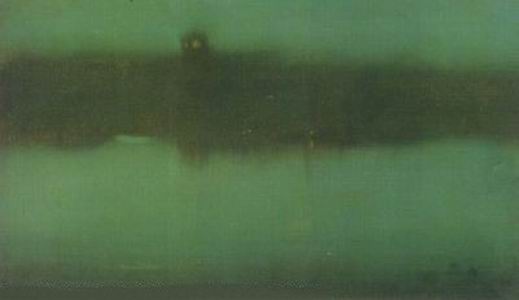
The well-planned layout of the exhibition allowed one to make
immediate visual comparisons to how each artist approached similar
subjects such as townscapes, riverscapes and smazescapes and sensation
states - the sensation of mist and smog in the city. Whistler’s
serene Nocturne in Grey and Silver (1873-75) is arguably
his finest painting of the show with its mesmerising mist, distilled
cool silence, appearing almost Rothkoesque. It is also strikingly
similar in moody mistyness to Monet’s mauve and lavender
The Seine at Giverny, Morning Mists, 1897. Whilst both
images are painted in different styles and times of the day, the
Whistler, depicting evening mist, is painted with invisible brush
strokes, whilst in the Monet the brush marks are visible and form
the image of the morning mist. Both have a strikingly similar
mesmerising and shimmering quality arrived at by differing techniques.
Whistler’s subtle translucence is partially achieved by
the thinning down of oil paint with turps – peinture
al’essence – perhaps partially derived from observing
Turner’s opulent watercolours.
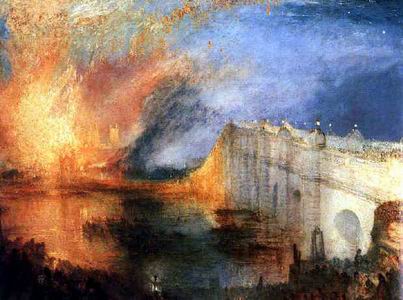
Whistler’s night-time views of the Thames, The Nocturnes,
were painted from memory in the studio just as Turner’s
Burning of the Houses of Parliament (16th October, 1834)
was painted in the studio from a series of pure watercolour sketches
he painted ‘live’ in a boat on the Thames, observing
the action as it happened: seeing these vibrant watercolours on
display for the first time reminded me of the fiery intensity
of Emil Nolde’s watercolours in their burning primary colours.
Whereas Turner painted the Houses of Parliament literarily in
flames, Monet painted the Houses of Parliament, Sunset
(1904) where river, sky and Parliament all appear to be aflame
with the setting sun. Whereas Turner depicts Parliament burning
Monet actually sets the Thames alight as liquefying flames: Parliament
is floating in a river of fire.
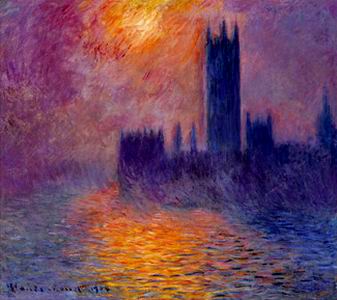
In stark contrast to Turner and Monet, Whistler’s sombre
and serene palette and the melancholic moods of his Nocturnes
are strikingly reminiscent of Jawlensky’s dark and brooding
Mediations. Whistler’s Nocturnes nurture the murky moments
and moods of the twilight-zone, hovering between light and dark,
smudging the vision of the viewer and producing a silent shudder.
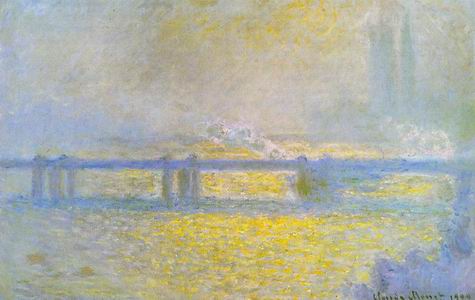
For me the most stunning, dazzling and mesmerising painting was
Monet’s Charing Cross Bridge Overcast Weather (1900)
and no reproduction I have ever seen does it full justice. The
sparkling and shimmering orange flicks of paint become gold tears
reflecting the boiling hot sun.
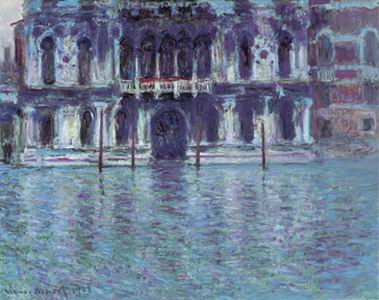
At the end of the exhibition we are confronted with Monet’s
murky Palazzo Contarini (1908) whose haunting and ghostly
qualities return us to the twilight zone of Whistler’s mesmerising
Nocturnes: the stone masonry has a soft jelly-like, shimmering,
melting quality as if sinking into the lagoon which reflects and
refracts it. The Palazzo is truncated and severed by the frame
giving the impression that it is sinking and being devoured by
the violently lapping water and creating the sensation of a crushing
claustrophobia. Here the Palazzo is under siege by the invasive
rising waters of the lagoon.
Monet’s dazzling, muscular and musical
image of this vibrating, sinking palace left me with a floating
feeling, and I left elevated and dazed. Yet, the only problem
with this outstanding exhibition was that there was not one bad
image in it; one had to censor what one saw in order to prevent
becoming overwhelmed by sheer bedazzlement and fatigue.
Alex Russell




